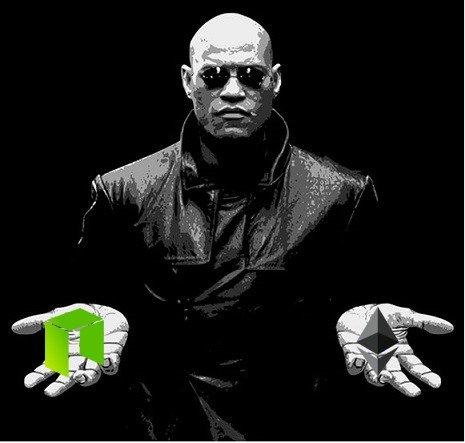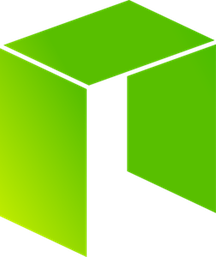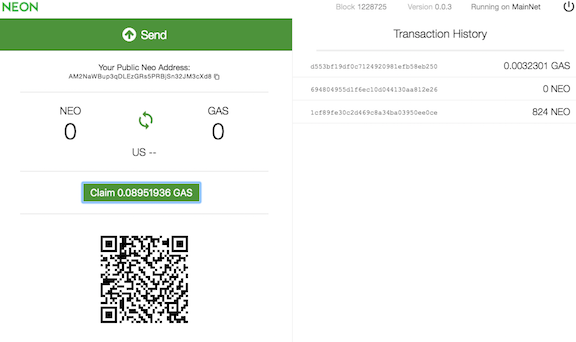NEO is a platform with a purpose. Can it compete with Ethereum? Or better yet, does it even need to?

Why Read This Article?
NEO and Ethereum — which pill will you take? Sorry, couldn’t help myself. We care about this debate because we’re investors. From a developer’s perspective, functionality is the most important. There is no brand loyalty in blockchain yet. So if a platform can do something better than its competitors, it will win over developers. So which one does it better?
This article is long because I have chewed through all the information I could find about NEO and Ethereum and digested it for you. There are lots of articles summarizing the “differences” between Ethereum and NEO, but they do the debate little justice. They skim over things, don’t explore them well, explore only one aspect, or aren’t holistic in their analysis and don’t explain why the differences even matter and what their relevance to the real world is. I was frustrated by the lack of a comprehensive article. This article is my response.
I will admit that I explore NEO more in-depth than Ethereum. This is because so much information is widely available for Ethereum. With NEO, there is much less. As such, I focus on explaining NEO and then comparing that explanation to Ethereum’s capability.
So bear with me, grab yourself an espresso and lock yourself in that room you “do work in.” This will be well worth your time. I also won’t blame you if you just read the TLDR — Too Lazy, Didn’t Read — under the articles.
Let’s begin
If Ethereum is Goliath, Neo is David. If Ethereum is Brad Pitt, NEO is Brad Pitt’s cousin, Zach Pitt—younger, better dressed, and more talented — but right now relegated to serving cocktails to Brad and his friends while he acts on the side. Ethereum did it first. It was revolutionary and exciting and took the crypto world by storm. Web 3.0. Today almost every ICO is built on Ethereum’s ERC20 token platform and Vitalik Buterin is one of our time’s greatest minds. Yet if we’ve learned anything from the fact that Alibaba is closing in on Amazon’s market cap and WeChat dominates China’s social media scene, it’s that China plays by their own rules. The Land of the Red Dragon uses their own technology, their own networks, and cares little for what the U.S. is doing. The question is, can NEO compete with Ethereum, and does it even need to?
Ultimately, Neo and Ethereum are aiming for similar roles in the crypto community. Both want to be platforms for the new internet: for DApps (Decentralized Applications), ICOs (Initial Coin Offerings), and smart contracts.
Overview of Ethereum and Neo
While both Neo and Ethereum have generalized blockchains that provide a toolbox for would be developers, their objectives differ. I would summarize each platform’s objectives as such:

Ethereum's goal is to create a platform for the development of DApps in order to create a “more globally accessible, more free, and more trustworthy Internet:” an internet 3.0.
NEO is a blockchain project “that utilizes blockchain technology and digital identity to digitize assets, to automate the management of digital assets using smart contracts, and to realize a “smart economy” with a distributed network.”
That’s a mouthful. Let’s breakdown these objectives to fully understand the projects. It’s important to understand that both platforms share many of the same capabilities, but the distinction in their branded objectives is very important.
Ethereum: Ethereum’s goal is to be the platform for DApps and they are largely accomplishing this. They own the DApp market right now. Their roadmap is all about giving users and developers more control and more options in developing their applications.
NEO: NEO is working towards developing a product for the future. It not only rebranded from Antshares to NEO in June of 2017, but they refocused their marketing as well — with enormous success. Neo’s objective, while ultimately utilizing many of the same technologies as Ethereum, is to be the platform for a new smart economy.
In short: Ethereum is developing in response to new demands. NEO is developing their platform in anticipation of future demands.
What is a Smart Economy?
The biggest difference between NEO and Ethereum is NEO’s focus on a smart economy. If we want to fully understand NEO, we need to understand why this distinction is important.
A smart economy will feature digitized physical assets. All of these newly digitized assets will have proof of ownership in the blockchain. These assets can be sold, traded, and leveraged through smart contracts. Their ownership can be protected and validated through the decentralized model of the blockchain. We’ve already seen iterations of this: from proposed supply chain overhaul to DAOs (decentralized autonomous organizations — essentially decentralized companies without a leader). I offered some real world examples of this economy in this article. Now while Ethereum will likely support many of the same capabilities that NEO has, the distinction between Ethereum and NEO’s objectives is what we care about.
The distinction is important because a smart economy will still be under a government and under governmental regulation. I don’t trust the government as much as your next libertarian; I’ve read 1984 too many times. But the fact remains that governments aren’t going anywhere. Thus, for a platform to service this “smart economy,” that platform needs to put specific thought and intention into how it will accommodate governmental regulation. So while Ethereum might offer the similar blockchain capabilities, the fact that NEO is developing FOR THIS PURPOSE is crucial.

TLDR: A smart economy is in our future. To accommodate the needs of this smart economy, the platform will need to be specifically designed for this new economy.
What is NEO doing to prepare itself for the smart economy?
NEO places particular emphasis on staying regulatory compliant.
To do this, they need:
Digital Identity
Anonymity is great. I think privacy should be at the forefront of today’s technological developments and discussions. But if companies and governments are operating on the blockchain, digitizing their assets, and issuing smart contracts, all under the watchful eye of the government, they can’t have anonymity. For a platform to be regulatory compliant, digital identity — a verifiable identity in digital form — is a necessary evil.
Today, digital identity is based on a system called the PKI (Public Key Infrastructure) X.509 standard. This probably means about as much as it does to you as it does to me. It just means that there is an international agreed upon standard for what constitutes a digital identity. NEO’s plan is to issue digital identities in accordance to this standard and then secure them using the blockchain. Bookkeepers (read about them later) will have digital identities and real names. Because of this, judicial action can be taken against them if ever need be. This is imperative when registering financial assets on the network and staying regulatory compliant.
There could also be businesses and projects that will only transact with people who have a digital identity, for regulatory reasons. NEO enables that possibility.
NEO is already working in a strategic partnership with THEKEY — a project being developed on NEO’s platform that will assist with providing digital identification.
What about Ethereum: Ethereum requires other DApps to develop digital identities which can then be secured on the Ethereum blockchain. This isn’t so unlike how it will work with NEO — however NEO has made it clear, through its plan to incorporate digital identity with its bookkeeper nodes, that integration of digital identity is of central importance to the NEO ecosystem.
TLDR: Governments don’t like anonymity. Industries don’t like pissing off the government. If NEO wants industrial adoption, it needs to have digital identities.
Digital Assets
A future digital asset?
If you want a smart economy based on smart contracts, you need to be able to leverage and exchange assets beyond currency. We need to be able to digitize assets like house, property, and car ownership; gold, diamonds, and other precious elements; computers, clothes, and food; even those baseball cards your mom keeps begging you to throw away. Smart contracts become so much more powerful when we have the ability to digitize all of these assets.
What about Ethereum: Very similar to the digital identity blurb. Ethereum absolutely can secure digital assets, but they won’t necessarily be regulatory compliant. NEO is ensuring that issued digital asset certificates will be compliant.
TDLR: Just read it
NEO’s complex network
The economy is complex; it has so many interconnected pieces. NEO’s platform is complex, with partnerships galore. Fully researching and understanding this is difficult. But I did it, so you don’t have to! Refer back to this visual to have a solid picture of how this network interacts.
Even though this looks like the deranged drawings of a conspiracist, it will make sense as you reference it while learning about NEO’s network
OnChain
NEO’s founders Da HongFei and Erik Zhang founded a company called OnChain. Understanding OnChain is critical to understanding NEO. They’re not the same company, but their interests align and they have a partnership together. OnChain’s system, known as DNA (Decentralized Network Architecture) aims to work with Chinese businesses and government. NEO acts as the foundation of DNA. If OnChain can integrate with Chinese businesses and government, that will greatly spur adoption of NEO.
Ultimately, DNA develops public and private blockchains for businesses. These blockchains then link up to NEO to join the decentralized economy. Businesses then have all the benefits of both private and public blockchains. Think of NEO as providing the public blockchains and OnChain’s DNA providing the private blockchains. Then, they can link up and get the best of both worlds.
OnChain also has several projects and partnerships and newsworthy mentions that all contribute to the DNA ecosystem:
- Established in 2014, this is not a fresh-off-the-shelf company
- First Chinese blockchain company to join Hyperledger — a collaboration of projects that work towards integrating blockchain with established businesses.
- Legal Chain — works with Microsoft China in digitizing and securing signatures via blockchain technology.
- Strategic partner of Microsoft China on multiple projects
- Worked with the Japanese Ministry of Economy, Trade and Industry
- Voted as KPMG’s top 50 Fintech Company in China
- Partnership with Alibaba to provide an email certification service for Ali Cloud
- Investment from Fosun Group—China’s largest private conglomerate — to integrate OnChain across their businesses.
- Collaboration with Chinese regional government — using OnChain to develop public services and digital identity
OnChain’s recent development was of the ICO Ontology. Ontology uses the same architecture as NEO but ultimately works with businesses in creating a private, encrypted data network. Essentially, this is important when we have information that we need securing, but we also need it to be private. This will enable people to bring this information in a secure manner to blockchains.
References on OnChain’s RoadMap
Honestly, I don’t understand why NEO doesn’t advertise their collaboration with OnChain more. NEO in itself is solid, offering several potential benefits over Ethereum. But combined with OnChain, NEO truly has the potential to implemented itself as THE smart economy platform of the East.
The Ethereum Comparison: Ethereum’s equivalent is the Enterprise Ethereum Alliance, an open source blockchain initiative dedicated to linking Ethereum with the business world. Their list of partnerships is robust and impressive — no surprise for those familiar with Ethereum. Included among their members are: BP, HP, Toyota, MasterCard, Microsoft, and Intel, among many others.
TLDR: OnChain is a company partnered with NEO. They have extensive experience and many accolades in bringing blockchain to businesses. They work with companies and governments in the East. They are a huge component to NEO’s potential.
NEOX:
NEOX is NEO’s version of atomic swaps (directly swapping tokens without any exchange) and cross-chain integration. Think Ark Ecosystem. This will enable people to swap crypto assets and transact across different blockchains. It also allows smart contracts to interact across chains.
NEOX is important because it allows collaboration between the blockchains (both private and public) created by OnChain and by NEO’s public blockchain. As more components of the Smart Economy develop, NEOX will link them all together.
Ethereum Comparison: Ethereum has the ability to do atomic swaps, but has only completed this once — this isn’t to put down Ethereum; NEO has never completed one. However, Ethereum will need an outside application to accommodate large scale cross-chain integration.
City of Zion:
City of Zion (CoZ) is an independent, open source community of developers, translators, and designers who work towards the betterment of NEO. They have received funding from NEO to help incentivize project development. The community has contributed considerably to NEO. They have developed the NEON wallet, created a NEO block scanner, translated documents for NEO, and developed the NEX platform (see below). They recently received NEO funding to award $270,000 to 10 winners as part of their DApp competition. It is incredibly advantageous to have a network of support such as CoZ.
Not quite the City of Zion we’re talking about…
Ethereum Comparison: There isn’t really a good comparison for this on the Ethereum network.
NEX:
Nex is an upcoming ICO developed by City of Zion that offers a platform for the creation of payment solutions and decentralized exchanges on NEO. It links to NEO with NEOX.
Because of differences with NEO in the token model, account balances, and way smart contract interact — in comparison to Ethereum — NEO needed a solution to be able to effectively house decentralized exchanges. NEX offers that solution.
Ethereum Comparison: Already ERC20 tokens are easy to transact with on decentralized exchanges.
ProjectICO:
A turnkey, all-in-one ICO company that helps blockchain companies develop: from initial idea to ICO. They recently decided to move from Ethereum to NEO. They have an interesting Reddit AMA on their reasons for switching.
Ethereum Comparison: TokenHub is a similar project developing on Ethereum.
Microsoft China:
NEO is currently hosting a developer competition in partnership with Microsoft China with $490,000 as prize money.
Ethereum Comparison: Ethereum is incredibly well connected with established corporations. NEO is playing catchup.
DApps and ICOs:
The bread and butter of platforms; until now, NEO has only had one ICO (Red Pulse) and one DApp (AdEx). However, with several planned in the near future and with an upgrade last month which will enable NEO smart contracts to interact with website interfaces, I think this is only the beginning for NEO.
Ethereum Comparison: Ethereum hands down beats NEO in this area. Ethereum is the go-to platform for ICOs and DApps.
Ecosystem Recap
We hopefully have a strong understanding of the differences in the goals of Ethereum and NEO, as well as a good overview of NEO’s network and the network’s advantages in the smart economy. It’s important to understand this network for NEO because NEO is more than just a public blockchain, it is a piece in the larger picture. When NEO’s public blockchain can link up with OnChain’s private and business oriented blockchains and ultimately with all other DApps on it’s platform, it could truly become a smart economy.
The biggest differences between Ethereum and NEO
Ethereum’s energy consumption could power 1,025,438 American homes for a year. — Source —
Protocol
Ethereum uses the same protocol as Bitcoin — Proof of Work (PoW). With Proof of Work, computers on the network compete to solve mathematical formulas and win the right to confirm transactions into the blockchain, and thus, secure the network. The two major drawbacks to the PoW protocol is the danger of a 51% attack and the massive energy consumption required for network security. For these reasons, I think that PoW will soon be an outdated system, as blockchain transitions to a new protocol called Proof of Stake (PoS).
Proof of Stake works similarly to PoW except that instead of computers validating the network and receiving rewards equivalent to their relative computing power, PoS uses token holders. Those who hold tokens can “stake” their tokens (staking means to temporarily place the tokens in a locked smart contract — until staking is over) and in exchange, confirm transactions and receive rewards based on the relative number of tokens held. In PoW, if you operate 5% of the total computing power of the network, you can expect to get 5% of the block rewards. In PoS, if you own 5% of tokens, you can also expect to receive 5% of block rewards.
PoS offers a solution to the issues plaguing PoW — mainly it takes virtually no energy to run PoS — without compromising the security. I would argue that it actually improves security. With Ethereum, and all other PoW protocols, the difficulty algorithm (how hard it is to solve the mathematical formula) must constantly be updated to account for better computer hardware and more powerful mining groups. With PoS there is no need to do this. With Ethereum, you could conceivably purchase enough computing hardware to achieve a 51% attack; even after comprising the network, you would still have all of that hardware and could potentially use it to attack other PoW platforms. With PoS, because you must stake your coins, any malicious behavior results in the loss of all staked coins. So if you bought 51% of all tokens, you would immediately lose your substantial investment. In addition, the costs of purchasing 51% of the network tokens are equal for everyone. The costs of obtaining 51% of computer power — due to discounts for mass computer purchases and countries with extremely cheap electricity — are not.
NEO uses a protocol called dBFT (Delegated Byzantine Fault Tolerance) which sounds like a term you’d see on your AP History Test. The simplest explanation of Byzantine Fault Tolerance is the issue with how to get everyone on the network to be honest and work together — because one bad apple could ruin everything. NEO’s dBFT is a modification of the classic PoS protocol, with some significant advantages and one primary disadvantage.
Byzantine Fault Tolerance attempts to solve the Byzantine General’s Problem

I imagine dBFT as working similar to how the U.S. Senate works (and if that analogy made you want to just give up on Neo entirely, I understand, but hold on…keep reading). If every person in America — all 323.1 million—was allowed to directly participate in the governmental decision making process, it would be catastrophic. It would be brutally slow as millions competed for the microphone, all shouting their opinion and arguing with each other. Making decisions would also be agonizingly slow. So instead, everyone in the country gets a vote. And with this vote, they can elect their representatives, someone to speak for them. This system directly reflects NEO’s governance. Instead of everyone getting to participate in the validating process — which can be incredibly limiting in terms of transaction speed — those who hold NEO tokens can vote for delegates. These delegates (called bookkeepers) maintain the network for everyone. Thus, NEO can run faster, more efficiently, and with quicker and more finite decisions, and you can stay home, drink Bud Light, and watch the Patriot’s game with your computer in sleep mode.
Remember too that these bookkeepers will have their digital identity known, making NEO much more compliant with national regulations.
The disadvantage with this system is a lack of decentralization. In its purest sense, instead of thousands of validators being scattered all across the world, governance is concentrated in a few dozen validators. The majority of these nodes are currently operated by the NEO team. However, as of Quarter 1, 2018, NEO will hold less than 2/3 and will continue to hold fewer as time progresses. Regardless, NEO will never be as decentralized as other pure PoS platforms.
I would however argue that Ethereum is also not as decentralized as you might think. While the PoW protocol is decentralized, you can count the number of core developer’s for Ethereum on one hand. In addition, while I trust Vitalik Buterin, he does have enormous power and influence over the direction of Ethereum.
Ethereum will transition to a PoS protocol in the future. They already have begun the process and the mining difficulty of confirming new blocks will increase exponentially until it is impossible to mine anymore and everyone must transition to the PoS protocol. This will happen but it is likely more than a year out.
TLDR: Ethereum uses a Proof of Work protocol and will evolve into Proof of Stake. NEO uses a Delegated Byzantine Fault Tolerance (dBFT) protocol which is a modification of the standard proof of stake protocol.
Transaction Speed:
Because NEO doesn’t run on PoW and has a more streamlined PoS protocol, NEO can process transaction far more quickly than Ethereum. Now when we compare these, there are both theoretical and practical speeds. Theoretical transaction speeds are the absolute maximum speed mathematically possible for the network. For NEO, this number is 10,000tps (transactions/second). Ethereum can do 30tps. In practicality, because of real world inconsistencies and difficulties, NEO can do 1,000tps in comparison to Ethereum’s 15tps. As protocols improve it is possible that both platforms will approach their theoretical speed.
This is an enormous difference and a massive advantage for NEO. NEO’s transaction speeds could conceivably accommodate the kind of smart economy they’re envisioning; Ethereum’s can not. Now in exchange for this speed, NEO is not as decentralized as Ethereum. In addition, it’s important to recognize that Vitalik and Ethereum are well aware of this limitation. Solutions such as Raiden and sharding (two fascinating technologies but far beyond the scope of this article) are on the roadmap for Ethereum and could drastically improve Ethereum’s transaction speed.
TLDR: Ethereum can transact at 15tps with a maximum of 30tps. NEO can transact at 1,000tps with a maximum of 10,000tps. Ethereum has plans and solutions to scale to close this gap.

Forking and scaling:
Ethereum forks to update its software, just like Bitcoin. I describe this here. Forks aren’t necessarily bad, but they certainly can be. Look at Ethereum’s DAO fork for an example of this. After millions were stolen from an Ethereum smart contract, Ethereum forked to refund the money to the original holders. Whether or not this decision was correct, it divided the community and Ethereum Classic was created alongside Ethereum.
Forks happen because there is no finality in the consensus mechanism of Ethereum. Multiple chains in the blockchain can be created at once — ultimately, both are valid chains and can continued to be mined on. Forks happen constantly but are usually resolved when the chain with the most computer power is chosen as legitimate. With Ethereum, it’s always recommended that when you place a transaction, you wait until a few blocks have been mined on top of yours before considering the transaction finite.
NEO has finality. This is because the bookkeepers must reach a 66% consensus for the transaction to be placed into the blockchain. Here is an analogy to understand this. Imagine a first grade class. Timmy asks how much chocolate milk costs. Cynthia has no concept of price (she’s in first grade for god’s sake) and shouts $15! A few students walk over to her in agreement. Bobby’s a chocolate milk aficionado — he knows his milk. He says $1.25. Most of the room walks over to him. He has a majority. Now assuming Cynthia’s group realizes their flaw and joins Bobby’s group, then the group reaches consensus. But if Cynthia is having a particularly stubborn day, she could keep on with her decision — a fork. It might not be the right answer, but she still has a valid answer. This is how Ethereum works.
NEO works like this. Imagine the same scenario. Timmy again asks how much chocolate milk costs. First Cynthia speaks up: “$15!” A few murmur in support, but it’s clearly not 66% of the class so her idea is discarded. Next Bobby says “$1.25.” 66% of the class support his claim and thus, his idea is final. With NEO, the bookkeepers each propose the correct state of the next block. When 66% of them support the proposition, the block is finalized.
The implications of this are huge. Finality is incredibly important for the type of economy NEO hopes to support. The financial industry and other complicated, fast moving markets (stock markets for example), can’t operate on a system without finality. They need to know that when their information is placed into the blockchain, it is there for good. They also need the assurance that their blockchain won’t suddenly become irrelevant because of a fork.
TLDR: Ethereum can fork; NEO can’t — this is important for adoption by our real world economy.
Decoupling of GAS and NEO
This may very well be NEO’s most ingenious characteristic. The native token of Ethereum is ether. The gas needed to run the Ethereum network (execute contracts, conduct transactions, etc.) is actually just small units of ether. There is no separation between ether and gas.
However, NEO decoupled itself from the token needed to run the network: GAS. The NEO token is like partial ownership of the NEO platform. NEO token holders are entitled to vote for bookkeepers. NEO’s use as a share in the company rather than a token is furthered by the fact that NEO is non-divisible. NEO is not meant to be transacted with — that’s why there is GAS.
GAS is used for all operations on the NEO network. Now when a company registers or changes assets on the NEO blockchain, they pay in GAS — this GAS is then distributed to all NEO holders. Anyone can claim this GAS by just holding their NEO in a personal wallet. Such as this one: NEON
Bookkeepers are entitled to charge a transaction fee (in GAS) for general transactions on the blockchain that only they (the bookkeepers) receive. However, by decoupling NEO and GAS, there is an incentive to keep transaction fees low; here’s why:
High transaction fees, which only benefit the bookkeepers, will prevent people from wanting to register their assets on the blockchain. The less assets registered, the less rewards NEO holders will get. Thus, NEO holders are incentivized to vote in bookkeepers who will keep transaction fees low.
“Low transaction fees = more users = more assets registered = more GAS to NEO holders.” — Malcolm Lerider from his article
Bookkeepers are primarily incentivized by their desire to secure the network. They use the network, benefit from it, and have money staked in NEO. Thus, it is advantageous for them to secure it.
It is unclear how rewards will be divided amongst ether holders when Ethereum becomes Proof of Stake. However, it appears that only large Ethereum holders will be able to stake and receive rewards.
The NEON Wallet with the “claim gas” button
The genius of the NEO token is that it allows users to passively acquire GAS in their wallet. No need to run the computer, keep the wallet open, or expend electricity. No need to “stake” your tokens — bookkeepers do this for you. You could even have your NEO in a paper wallet. GAS is collected when you physically push the “claim GAS” button. This also ensures that the NEO network doesn’t need to calculate the interest of NEO holders with every block, reducing traffic and simplifying the compound interest formulas. The delegated bookkeepers maintain the network; your investment gains interest. This would not be possible without two separate tokens.
Both NEO and GAS are capped at 100 million tokens.
TLDR: Ethereum has one token: ether. NEO has two: NEO and GAS. There are huge advantages to having two tokens when using a proof of stake protocol.
Smart Contract Language
The biggest difference between Ethereum and NEO smart contracts is the coding language options available. With Ethereum, contracts must be written in solidity — A coding language created specifically for Ethereum. NEO on the other hand supports a variety of different languages, including the most commonly known. NEO supports five programming languages with plans to support an additional five in the future.
There are certainly advantages to crafting a particular language for a particular platform. Ethereum developers designed solidity for Ethereum. However, far fewer people know solidity. By supporting the most common coding languages, NEO has an advantage in facilitating adoption. Most programmers today would have to learn solidity before working with Ethereum whereas with NEO, their knowledge is already applicable. It’s also possible that existing business platforms could be placed onto the NEO blockchain without much modification.
TLDR (seriously? It’s like two paragraphs): Ethereum has one coding language: Solidity. NEO supports many different coding languages.
Smart Contract Execution
Smart contracts use what are called virtual machines (VM). Essentially, in layman’s terms, virtual machines are machines that execute smart contracts and run inside the computers of miners or other validators. The VM is the environment that the smart contract runs in. Thus, if we want to know how efficient and effective smart contracts can be, we need to analyze the VM.
NEO’s VM optimizes smart contract code before executing the contract. What this means is that it takes the code and reorganizes it to make it more efficient. Imagine your mom gives you a grocery list. If it’s anything like my mom’s lists — and she will probably object to this — the items have no organization and I am constantly ping-ponging back and forth across the grocery store. But by organizing all the items into categories that I can then pick up together at the same part of the store (dairy, canned goods, cereals), my job becomes much quicker and easier. NEO does this; Ethereum does not. Now while this makes things much easier in the long run, in the initial phase it takes a bit longer to organize the list. NEO’s contract execution takes slightly longer than Ethereum’s, but is much more efficient in the long run.
Ethereum plans to roll out this mechanism, but there is no timeline for it. Ultimately, this allows NEO to execute and run complex smart contracts faster and more efficiently than Ethereum.
TLDR: NEO has a more efficient and faster way of executing smart contracts than Ethereum.
Additional Important Differences
- NEO is theoretically quantum computer resistant, Ethereum is not — When quantum computers develop enough, blockchains could be vulnerable. NEO has theoretically designed their blockchain to account for this. Ethereum does not have that capability.
- sk-Snarks: Ethereum’s new privacy tool. sk-Snarks is the privacy protocol of ZCash. While there are far smarter people who can explain the technology far more intelligently than me, essentially sk-Snarks is important when we want to have data or contracts of which the contents is private or confidential. We need to maintain the privacy of the data, but at the same time, prove we have ownership of it. sk-Snarks allows users to prove they have ownership without actually giving up the private data. NEO has no such capabilities. However, NEO’s partnership with OnChain’s Ontology offers NEO a privacy solution for businesses.
NEO’s Recipe for Success
In my opinion, NEO has two possible avenues for success. Neo’s two paths towards success are:
- The above mentioned benefits allow it to compete with Ethereum directly and it begins to be the go-to platform for ICOs and blockchain development.
- It doesn’t compete with Ethereum but instead becomes the DApp platform and foundation of a smart economy in the East.
The First Possibility
I think this is the least likely of the two paths to success. Yes, NEO beats Ethereum on several fronts. But Ethereum already is an established platform. And Ethereum will close the gap with its scaling plans in the future. To overtake Ethereum will be very difficult. However, I do think that NEO has a lot more room to grow, even if it can’t fully compete with Ethereum. Already we’ve seen an influx of ICOs developing on NEO — this will increase. And as it does, NEO’s price will increase. I also believe that eventually the market will support more than one platform. But that doesn’t mean NEO will ever replace Ethereum, especially in the West.
The Second Possibility — some political analysis in here too
This is definitely the most exciting of the two possibilities. Take the almost 1.4 billion Chinese; add to that an even larger untapped market in the surrounding area and that means that the blockchain platform that captures this market will make Ethereum’s $44 billion marketcap look like chump change. And as I wrote about before, China uses their own products and businesses. The issue is, we don’t even know if China is looking for a platform. Currently, China has banned all ICOs and exchanges. If the ban continues, no one will capture the Chinese ICO market — because there will be nothing to capture. So the question then is, if — and it’s a big if — China legalizes ICOs, can Neo be the big man on the block?
In my opinion, China will soon open up blockchain development. China right now sees an opportunity to be a global political and economical leader. Already with the world’s largest GDP, China is not afraid to adopt and evolve for the benefit of their economy. Their dedication to renewable energy exemplifies this. China was certainly not known for their environmental friendliness; but they recognized that the world was moving in that direction; they recognized the benefits it offered; and they recognized the enormous potential if they could lead the pack. And now? China is the leading investor in renewable energy.

Additionally, China’s political structure means that development can happen fast. They can evolve quickly and lead world renewable energy efforts because they are a one-party state. There is no balance of power and need to appeal to a divided voter base delaying development as there is in America.
China knows that blockchain is going to be extraordinarily disruptive. They demonstrated this when they released their five-year blockchain plan. China banned exchanges and ICOs because they recognize the potential of blockchain. If they didn’t understand its significance, they never would have banned it. They banned it because they want to control it; because they will control it. They banned it to flex their muscles, establish their power, and give them time to formulate a plan for how and when they will move forward. It’s very difficult to influence things when adoption has come; it’s much easier to impose early restrictions and shape the direction of the disruption.
When they have their plan, they will likely become the world’s leading country in blockchain technology. And with the capability for rapid economic development, when China opens up ICOs and blockchain development…look out.
The question then is, what will China utilize? It’s possible that they design their own governmental blockchain services, but I think this is incredibly unlikely. China integrated with social media, not by banning it or by creating their own platform. Instead, they integrated by selectively banning western social media and directing the Chinese market to Tencent — in exchange, Tencent employs communist workers, stays regulatory compliant, and maintains the party’s censorship. And now, Tencent is bigger than Facebook. Thus, I believe that China will join the blockchain world by integrating with an already present platform; one with a willingness to work with the Chinese government; one with a focus and framework that will support governmental compliance. NEO and OnChain fit that mold. Their work and partnerships within China, NEO’s development and dedication to compliance, and their envisioned smart economy gives me confidence that when the day comes, NEO could be China’s platform.
Recognize that this is my own opinion. Nothing is guaranteed, especially in the crypto space. All we can do is formulate a hypothesis and provide a strong supporting argument; I hope that I at least did that.
Summary
Ultimately, if I had to categorize NEO and Ethereum in a few words, I would say that NEO is Ethereum but with a specific purpose: to enable a smart economy. Ethereum is just a platform to enable entrepreneurship, innovation, and development — the direction it goes is up to those individuals building on Ethereum. NEO has a direction; it is shaping its platform with a goal in mind.
Yes, NEO has some definite advantages over Ethereum, but as I said, Ethereum will likely scale to close the gap as the platform gains adoption. NEO’s true value is in its dedication towards fitting the mold for a regulatory compliant smart economy platform. They are doing this; now China just needs to takes notice.
FOLLOW me on Twitter: @noamlevenson
Disclaimer: I am invested into both Ethereum and NEO. This is not investment advice, merely my opinion on the platforms. Do your own research.

I found your post and decided to help you get noticed.
I will pay a resteeming service to resteem your post,
and I'll give you my stamp of automatic approval!
Curious?
introduction post
Check out the great posts I already resteemed.Resteemed by @resteembot! Good Luck! The resteem was payed by @greetbot The @resteembot's Get more from @resteembot with the #resteembotsentme initiative
Congratulations @noamlevenson! You received a personal award!
Click here to view your Board of Honor
Congratulations @noamlevenson! You received a personal award!
You can view your badges on your Steem Board and compare to others on the Steem Ranking
Vote for @Steemitboard as a witness to get one more award and increased upvotes!